Social policies
The Nazis introduced policies to control religion, German youth and to promote and encourage the idea of a superior Aryan race. Through indoctrination they were able to keep control of, and influence the thinking of German citizens.
Controlling the Catholic Church
On the 20th June, 1933 the Concordat was signed.
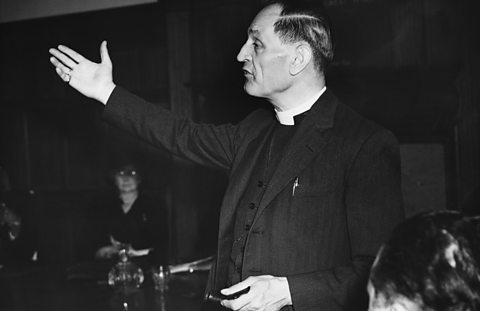
This agreement between the Nazis and the Pope stated that the Catholic Church in Germany would be protected. In return the Church would stay out of political matters and not criticise the Nazis.
This allowed Hitler to ban the Catholic Zentrum party without opposition from the Catholic Church.
Despite signing an agreement with the Pope, the Catholic Youth League was broken up, Catholic priests arrested and religious teaching banned.
Hitler set up a тGerman Christian Churchт with Nazi bishops. Ministers, such as Martin Niemoller, who resisted by setting up the Confessional Church, were sent to concentration camps.
Controlling the German Youth
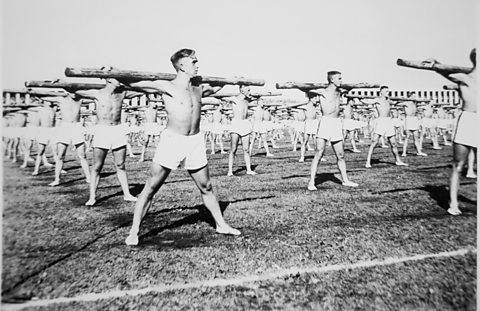
The Nazis tried to brain-wash the German population into believing in the Nazi way of life. They believed that the best way to do this was by changing the minds of the young so they would grow up to become Nazi supporters.
Education was controlled by the state. Nazi education was aimed at developing young adults who believed fully in Nazi ideals.
- Teachers and university lecturers had to join the National Socialist Teachers' League - this questioned their suitability to teach
- They were forced to teach to a very specific curriculum
- Anti-Nazi and Jewish teachers were sacked
- Textbooks were re-written to emphasis militarism, as well as Nazi political and racial beliefs.
School subjects were given a pro-Nazi bias. For example, history was taught to glorify Germany and biology instructed that pure Germans were superior. There was a strong emphasis on militarism in subjects such as maths, where problems would be presented in terms of the army or war.
Nazi Youth Groups were introduced to help control German youth outside of school and to prepare them for life in the Third Reich:
- Boys were encouraged to join youth groups which progressed to the Hitler Youth
- Hitler Youth were taught survival techniques, military skills and the importance of physical fitness.
- Girls were encouraged to join youth groups which progressed to the League of German Maidens
- Girls groups stressed the importance of a high birth rate and how to be a good wife
Promoting the Aryan race
The Nazis believed that Nordic and Germanic people belonged to a superior race of human, the Aryans. They wanted to increase the Aryan birth rate. They also wanted to remove тracial pollutionт
The role of women
To encourage the growth of the Aryan race, the Nazis saw the role of women as wives and mothers.
Women were expected to stay at home and look after the family. Women doctors, teachers and civil servants were forced to give up their careers.
The Law for the Encouragement of Marriage gave newlywed couples a loan of 1,000 marks, and allowed them to keep 250 marks for each child they had. Mothers who had more than eight children were given a gold medal. Unmarried women could volunteer to have a baby for an Aryan member of the SS.
Persecution of Jewish people and other groups
The Nazis believed that only Germans could be citizens and that non-Germans should not have any claim to the rights of citizenship. The Nazi racial philosophy taught that some races were тuntermenschт (German for тsub-humanт).
Many scientists at this time believed that people with disabilities or social problems were genetically less human and that their genes needed to be eliminated from the human gene-pool.
The Nazis carried out a number of actions as result of these beliefs:
- They tried to eliminate the Jewish people
- 85 per cent of Germany's Romani and Sinti people were killed
- Black people were sterilised
- Patients with mental illnesses were killed
- Physically disabled people and those with hereditary diseases were sterilised
- тAnti-socialт people were sent to concentration camps - included homosexual people, sex workers, Jehovah's Witnesses, alcoholics, pacifists, beggars, hooligans and criminals
Nazis persecution of Jewish people increased during this period.
1933
Jewish people were removed from public office and professions т civil servants, lawyers and teachers were sacked. School lessons reflected the view that Jewish people were ттuntermenschenт.
April Boycott
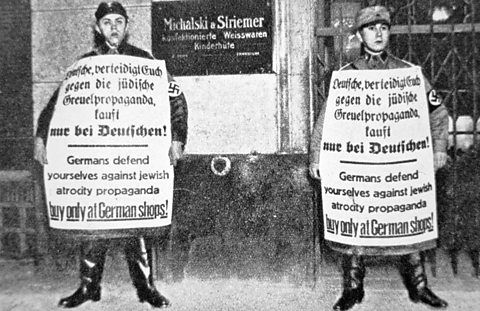
On the 1st April, a boycott of Jewish shops and other businesses took place. SA officers actively discouraged Germans from entering Jewish places of work. Many Jewish shops were vandalised.
1935 - Nuremberg Laws
The Nuremberg Laws were introduced at the Nuremberg Rally on 15th September. They removed many rights from Jewish people.
Jewish people were denied German citizenship. Marriage and relationships between Jewish and German people became illegal.
1938
- Jewish people were banned from becoming doctors.
- Jewish people had to carry identity cards which showed a тJт stamp.
- Jewish children were denied education and banned from schools.
- Jewish men had to add тIsrael to their name; women had to add тSarahт.
Kristallnacht
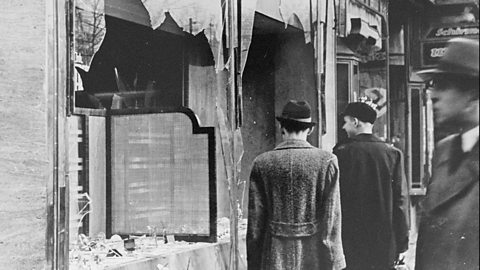
On the night of the 9th November, Jewish homes, businesses and synagogues were attacked throughout Germany and Austria. Around 7,500 Jewish shops were damaged or destroyed. 400 synagogues were burned to the ground.
Just under 100 Jewish people were killed and 30,000 were sent to concentration camps.
The Jewish community itself was forced to pay a fine of one billion marks to pay for the damage and afterwards had to clear the streets of all the broken glass.
1939
Jewish people were banned from owning businesses.
The first ghettoes (segregated housing within towns, with controlled entrance and exit) were opened in Eastern Europe to separate Jewish people from тordinaryт citizens.
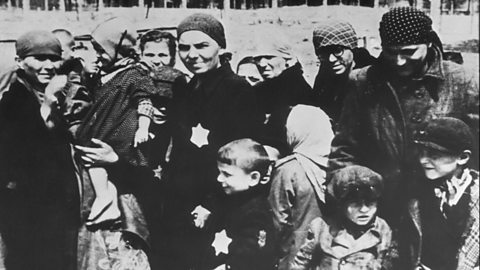
On 23 November, 1939, Jewish people were ordered to wear the Star of David on their clothes. This helped identify them more easily.
The Nazis' persecution of the Jewish people meant that many other Germans lived in fear of the Nazis turning on them.
This severely reduced the number of people who were willing to openly oppose the Nazis.
Moreover, in some circles, the Nazis were commended for such action and their support increased.